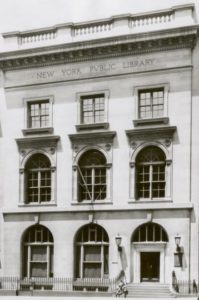

Feeding the Dragon
Jan. 11 – Feb. 4
Written and performed by Sharon Washington
Directed by Maria Mileaf
Past Issues
- A Christmas Carol (2017)
- Seder
- A Midsummer Night’s Dream
- Our Great Tchaikovsky
- Heartbreak House
- The Absolute Brightness of Leonard Pelkey
- Cloud 9
- The Comedy of Errors
- A Christmas Carol (2016)
- The Piano Lesson
- Queens for a Year
- Anastasia
- Having Our Say
- Romeo & Juliet
- The Body of an American
- A Christmas Carol (2015)
- Rear Window
- An Opening in Time
- Kiss Me, Kate
- The Pianist of Willesden Lane
- Reverberation
- Private Lives
- A Christmas Carol (2014)
- Hamlet
- Ether Dome
The Secret Apartments of the Carnegie Libraries
By Skye Robinson Hillis, Artistic Apprentice

In the late 19th century, Scottish-American industrialist Andrew Carnegie earned his vast fortune in the booming steel industry. Committed to philanthropy from early on in his career, Carnegie gave his financial support to a large number of projects throughout the United States and the English-speaking world. Carnegie sold his wildly successful steel company in 1901 to J.P. Morgan for $480 million, and spent the rest of his life dispensing his fortune among various charitable causes. He is best known for his support of schools, college, nonprofit organizations, and perhaps most notably of all, public libraries – nearly 3,000 in fact.
The libraries were at first donated to places that were close to his heart – his native country Scotland and his adopted home in Pennsylvania – but he soon began to extend his altruism. He believed help was owed to “the industrious and ambitious; not those who need everything done for them, but those who, being most anxious and able to help themselves, deserve and will be benefited by help from others..” A total of sixty-seven libraries were built in New York between 1899 and 1923, in each of the five boroughs.

These buildings on the whole were large, majestic, and cavernous, and could only be heated by a coal furnace heating system. These heating systems needed to be maintained day and night, and thus required a custodian to be on site at all times. To allow for this, small apartments were included in the design of these libraries on the top floor so that custodians and their families could live comfortably inside the library. While living there, they had full access to the library’s stacks and collections, and when the library was closed, could roam as they pleased. At St. Agnes, where the Washington family lived for many years, they also had access to the roof.
As the years have gone on, the heating systems in many of the libraries have been updated, and the need for an onsite custodian has been eliminated. Most of the apartments located within the libraries have been renovated to make space for other amenities, such as conference rooms and private reading areas. Only thirteen library apartments are left today.
